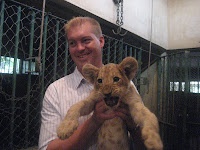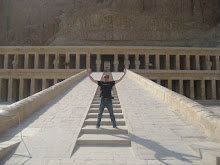As I proceeded to gawk at all of the temples and artifacts that are so old, I kept wondering how they were in such good condition. For the most part the majority of the temples, especially the large ones, such as Luxor, Edfu and Karnak were in pristine condition considering their age. Come to find out the main reason for their good condition was that they were buried in over 40ft of sand, deeper sometimes as though the temples range from 40ft to 90ft tall.
However, there were other temples like the Pyramids and the Sphinx that were not in such good of shape, even though they were buried the sand and I wondered just why this was? To my surprise it was a combination of two things, one more detrimental than the other.
The first reason for the deterioration of the monuments and temples was the exposure of the stones and paintings to the elements of the weather. Which is natural. Some of the temples were affected by flooding of the Nile, however even then, were relatively well preserved. The hieroglyphics were still carved into the rocks, the paintings were still there on the walls, and the mummies were still wrapped and preserved thousands of years after the people inside them had passed. Moreover though, it would take thousands of more years to actually destroy the temples in the manner that the 2nd reason, the human element had upon them.
The most detrimental thing to the monuments was the lack respect and knowledge applied to the ones that poked up out of the sand. At Edfu, only the top 10 or so feet of the walls of the temple rose above the sand, and instead of the preserving the carvings and paintings that were upon it, the armies that passed through the temple used the walls as target practice for the rifles, swords and arrows as well as a place for graffiti. Luckily, there was another 50ft of temple and hallways below the sand.
As for the Pyramids, the once used to be white instead of the yellowish stone that they have now. This is due to the stripping of the limestone, white in color, by the Arab Muslim invaders who conquered Egypt in 700+ A.D. and used the stone for the local mosques. I can’t say that the mosques here are not beautiful, but really, to destroy something so grand and well preserved, when there are beautiful granite rocks all around Egypt to carve from, they destroyed some of the greatest wonders in the whole world. I wonder if one day the limestone from the mosque’s will be re-used for another temple for another religion. Only time will tell.
So, I am a little bitter about the peoples that have lived on this ancient land for the past 2,000 years and their lack of respect and much less, their curiosity to learn and to preserve the wonderful things that existed on their land well before they did. Maybe it’s the Boy Scout in me, but I can for sure say that if I were to go roaming around in the Nevada desert or anywhere for instance, and I happened to stumble upon a monument, even a small one, that no one knew what it was, I would consider it a good fortune and the last thing I would do is shoot it or carve it up. Furthermore, to think, that I didn’t descend from the peoples that invented the calendar, papyrus, pie (3.14), irrigation, oh yeah and beer.
However, there were other temples like the Pyramids and the Sphinx that were not in such good of shape, even though they were buried the sand and I wondered just why this was? To my surprise it was a combination of two things, one more detrimental than the other.
The first reason for the deterioration of the monuments and temples was the exposure of the stones and paintings to the elements of the weather. Which is natural. Some of the temples were affected by flooding of the Nile, however even then, were relatively well preserved. The hieroglyphics were still carved into the rocks, the paintings were still there on the walls, and the mummies were still wrapped and preserved thousands of years after the people inside them had passed. Moreover though, it would take thousands of more years to actually destroy the temples in the manner that the 2nd reason, the human element had upon them.
The most detrimental thing to the monuments was the lack respect and knowledge applied to the ones that poked up out of the sand. At Edfu, only the top 10 or so feet of the walls of the temple rose above the sand, and instead of the preserving the carvings and paintings that were upon it, the armies that passed through the temple used the walls as target practice for the rifles, swords and arrows as well as a place for graffiti. Luckily, there was another 50ft of temple and hallways below the sand.
As for the Pyramids, the once used to be white instead of the yellowish stone that they have now. This is due to the stripping of the limestone, white in color, by the Arab Muslim invaders who conquered Egypt in 700+ A.D. and used the stone for the local mosques. I can’t say that the mosques here are not beautiful, but really, to destroy something so grand and well preserved, when there are beautiful granite rocks all around Egypt to carve from, they destroyed some of the greatest wonders in the whole world. I wonder if one day the limestone from the mosque’s will be re-used for another temple for another religion. Only time will tell.
So, I am a little bitter about the peoples that have lived on this ancient land for the past 2,000 years and their lack of respect and much less, their curiosity to learn and to preserve the wonderful things that existed on their land well before they did. Maybe it’s the Boy Scout in me, but I can for sure say that if I were to go roaming around in the Nevada desert or anywhere for instance, and I happened to stumble upon a monument, even a small one, that no one knew what it was, I would consider it a good fortune and the last thing I would do is shoot it or carve it up. Furthermore, to think, that I didn’t descend from the peoples that invented the calendar, papyrus, pie (3.14), irrigation, oh yeah and beer.



















